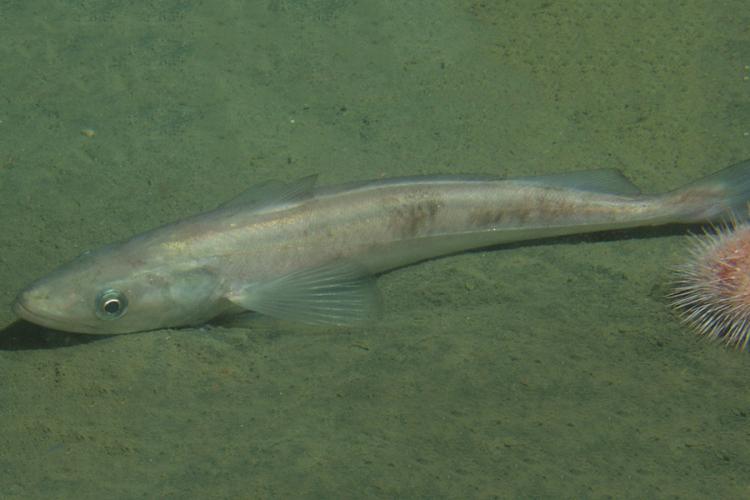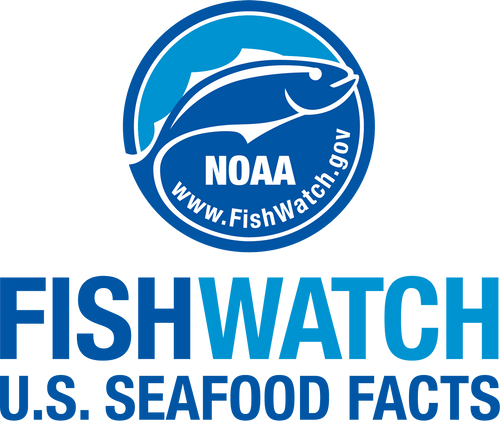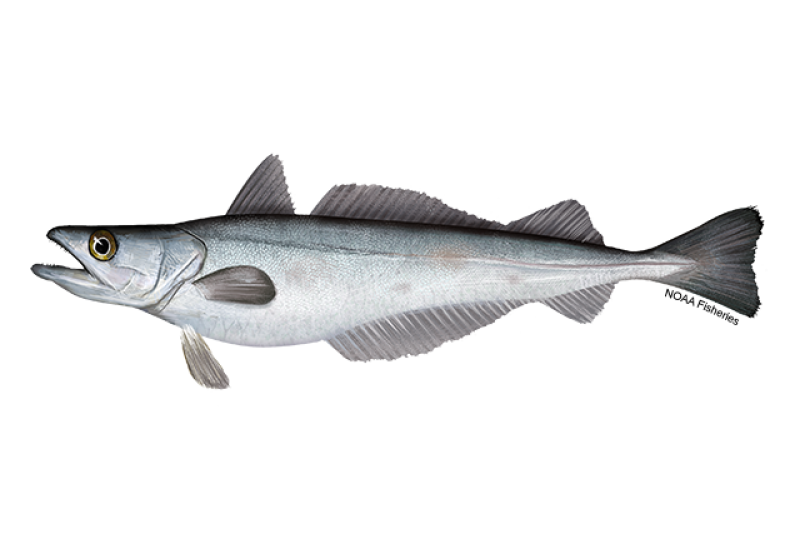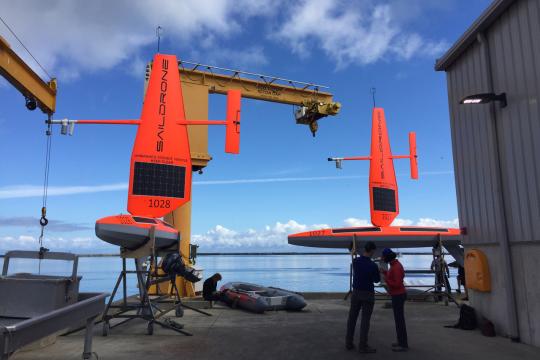Pacific Whiting
 Pacific whiting. Credit: NOAA Fisheries
Pacific whiting. Credit: NOAA Fisheries
Pacific whiting. Credit: NOAA Fisheries
About the Species
 Pacific whiting. Credit: NOAA Fisheries
Pacific whiting. Credit: NOAA Fisheries
Pacific whiting. Credit: NOAA Fisheries
Pacific whiting, or hake, is a ray-finned fish species found off the West Coast of the United States and Canada. They are a semi-pelagic schooling species of groundfish. There are three stocks of Pacific whiting: a migratory coastal stock, ranging from southern Baja California to Queen Charlotte Sound; a central-south Puget Sound stock; and a Strait of Georgia stock. While the latter stocks have declined substantially, the coastal stock remains large and healthy and is the most abundant commercial fish stock on the Pacific Coast. Pacific whiting are night-time predators that move up the water column to feed and then migrate back down during the day.

Population
The stock is not overfished.

Fishing Rate
Not subject to overfishing.

Habitat Impact
Mid-water trawls used to harvest Pacific whiting have minimal impact on habitat.

Bycatch
Bycatch is low because mid-water trawls target schools of whiting.
Population Status
- According to the 2022 stock assessment, the coastal stock of Pacific whiting is not overfished, and is not subject to overfishing based on 2022 catch data. Summary stock assessment information can be found on Stock SMART.
Appearance
- Pacific whiting is a round fish.
- They are silvery in color with black speckles on the back and black inside the mouth.
Biology
- Pacific whiting grow fast, up to 3 feet in length, and can live to more than 15 years old.
- Relatively little is known about their spawning season and locations. They are known to spawn in large numbers from January through March off south-central California, and were traditionally thought to migrate seasonally. However, recent studies have also shown that they may spawn as far north as Canada.
- In the spring, they travel nearshore and to the north to feed along the continental shelf and slope from northern California to Vancouver Island.
- In the summer, they form large schools along the continental shelf break. In years with warmer water temperatures, whiting tend to move farther north during the summer. Older whiting tend to migrate farther than younger fish.
- Female whiting are able to reproduce when they reach 2 to 4 years old (13 to 16 inches long). Males mature by 3 years of age (11 inches long).
- Females release their eggs, which males then fertilize externally. Eggs hatch in 5 to 6 days.
- They feed on shrimp, krill, and pelagic schooling fish, such as eulachon and Pacific herring. As whiting grow larger, fish make up a greater part of their diet.
- Many fish-eating species, such as lingcod and Humboldt squid, prey on Pacific whiting. Sablefish, albacore, pollock, Pacific cod, rockfish, sharks, and marine mammals also feed on Pacific whiting.
Where They Live
Range
- Pacific whiting is found off the West Coast from Southern Baja California and the Gulf of California to the Gulf of Alaska.
Habitat
- Pacific whiting school in midwater but have also been observed resting on the seafloor.
- They’re most common in water between 164 and 1,640 feet deep, but adults are found in water over 3,000 feet deep and 250 miles or more offshore.
Fishery Management
- The coastal stock of Pacific whiting is managed through the bilateral Pacific Whiting Agreement between the United States and Canada.
- The agreement allocates a harvest quota to American and Canadian fisheries. The United States is allocated nearly 74 percent of the annual quota and Canada the remaining 26 percent.
- NOAA Fisheries and the Pacific Fishery Management Council manage the Pacific whiting fishery on the West Coast, in U.S. federal waters (3 to 200 nautical miles offshore).
- Managed under the Pacific Coast Groundfish Fishery Management Plan:
- Permits and limited entry to the fishery.
- Certain seasons and areas are closed to fishing.
- Gear restrictions and area closures help reduce bycatch and impacts on habitat.
- Managers use annual harvest quotas to regulate the coastwide catch of Pacific whiting.
- There are several sectors of the U.S. whiting fishery, and managers divide allowable catch among them. Sectors include:
- Non-tribal catcher boats delivering to shore-based processing facilities.
- Non-tribal catcher boats delivering to at-sea mothership processors.
- Non-tribal vessels that both catch and process the catch at sea.
- Tribal harvesters.
- The shore-based trawl fishery, which includes vessels targeting Pacific whiting, is managed under the trawl rationalization catch share program that includes:
- Catch limits based on the population status of each fish stock and divided into shares that are allocated to individual fishermen or groups.
- Provisions that allow fishermen to decide how and when to catch their share.
- Total catch accounting and 100 percent observer coverage.
- The Pacific Whiting Conservation Cooperative was established in 1997 by fishing companies owning trawlers in the catcher/processor sector of the fishery.
- They allocate their catch quota among cooperative members to allow them to use the quota more efficiently. The result is a less wasteful, more environmentally friendly fishery that produces a higher quality product..
Harvest
- In 2022, commercial landings of Pacific whiting totaled 577 million pounds and were valued at $64 million, according to the NOAA Fisheries commercial fishing landings database.
- Gear types, habitat impacts, and bycatch:
- Mid-water trawls are primarily used to catch Pacific whiting.
- Mid-water trawling has minimal impact on habitat and low incidental catch of other species.
- Fishermen follow a number of regulations to reduce potential bycatch in the fishery.
- Mesh on the narrow, back end (codend) of their nets must be at least 3 inches to prevent bycatch of small fish.
- Regulations restrict where fishermen may harvest Pacific whiting to reduce bycatch of Chinook salmon.
- Each sector’s catch is restricted by limits on bycatch of Chinook salmon and depleted rockfish species.
- There is 100 percent observer monitoring on at-sea processors and catcher vessels.
- Recreational fishermen do not target Pacific whiting but sometimes catch them incidentally while fishing for other groundfish and salmon.
Scientific Classification
- Pacific whiting is found off the West Coast from Southern Baja California and the Gulf of California to the Gulf of Alaska.
- Pacific whiting school in midwater but have also been observed resting on the seafloor.
- They’re most common in water between 164 and 1,640 feet deep, but adults are found in water over 3,000 feet deep and 250 miles or more offshore.
Fishery Management
- The coastal stock of Pacific whiting is managed through the bilateral Pacific Whiting Agreement between the United States and Canada.
- The agreement allocates a harvest quota to American and Canadian fisheries. The United States is allocated nearly 74 percent of the annual quota and Canada the remaining 26 percent.
- NOAA Fisheries and the Pacific Fishery Management Council manage the Pacific whiting fishery on the West Coast, in U.S. federal waters (3 to 200 nautical miles offshore).
- Managed under the Pacific Coast Groundfish Fishery Management Plan:
- Permits and limited entry to the fishery.
- Certain seasons and areas are closed to fishing.
- Gear restrictions and area closures help reduce bycatch and impacts on habitat.
- Managers use annual harvest quotas to regulate the coastwide catch of Pacific whiting.
- There are several sectors of the U.S. whiting fishery, and managers divide allowable catch among them. Sectors include:
- Non-tribal catcher boats delivering to shore-based processing facilities.
- Non-tribal catcher boats delivering to at-sea mothership processors.
- Non-tribal vessels that both catch and process the catch at sea.
- Tribal harvesters.
- The shore-based trawl fishery, which includes vessels targeting Pacific whiting, is managed under the trawl rationalization catch share program that includes:
- Catch limits based on the population status of each fish stock and divided into shares that are allocated to individual fishermen or groups.
- Provisions that allow fishermen to decide how and when to catch their share.
- Total catch accounting and 100 percent observer coverage.
- The Pacific Whiting Conservation Cooperative was established in 1997 by fishing companies owning trawlers in the catcher/processor sector of the fishery.
- They allocate their catch quota among cooperative members to allow them to use the quota more efficiently. The result is a less wasteful, more environmentally friendly fishery that produces a higher quality product..
Harvest
- In 2022, commercial landings of Pacific whiting totaled 577 million pounds and were valued at $64 million, according to the NOAA Fisheries commercial fishing landings database.
- Gear types, habitat impacts, and bycatch:
- Mid-water trawls are primarily used to catch Pacific whiting.
- Mid-water trawling has minimal impact on habitat and low incidental catch of other species.
- Fishermen follow a number of regulations to reduce potential bycatch in the fishery.
- Mesh on the narrow, back end (codend) of their nets must be at least 3 inches to prevent bycatch of small fish.
- Regulations restrict where fishermen may harvest Pacific whiting to reduce bycatch of Chinook salmon.
- Each sector’s catch is restricted by limits on bycatch of Chinook salmon and depleted rockfish species.
- There is 100 percent observer monitoring on at-sea processors and catcher vessels.
- Recreational fishermen do not target Pacific whiting but sometimes catch them incidentally while fishing for other groundfish and salmon.
Scientific Classification
| Kingdom | Animalia | Phylum | Chordata | Class | Actinopterygii | Order | Gadiformes | Family | Merlucciidae | Genus | Merluccius | Species | productus |
|---|
Last updated by NOAA Fisheries on 09/09/2024
Featured News
 Vessels fishing for Pacific hake, shown here, sometimes inadvertently catch salmon in the wintertime fishery. The catch locations help understand the distribution of salmon in the ocean in winter. Photo by Jeff Bash/NOAA Fisheries.
Vessels fishing for Pacific hake, shown here, sometimes inadvertently catch salmon in the wintertime fishery. The catch locations help understand the distribution of salmon in the ocean in winter. Photo by Jeff Bash/NOAA Fisheries.
Commercial Fishing Regulations
NOAA Fisheries and the Pacific Fishery Management Council manage the Pacific whiting fishery on the West Coast in U.S. federal waters (3 to 200 miles offshore) under the Pacific Coast Groundfish Fishery Management Plan.
On May 15, 2018, NOAA Fisheries published a final rule (83 FR 22401) for the 2018 Pacific whiting fishery under the authority of the Pacific Coast Groundfish Fishery Management Plan, the Magnuson-Stevens Fishery Conservation and Management Act, and the Pacific Whiting Act of 2006. This final rule set the 2018 U.S. total allowable catch of 441,433 metric tons of Pacific whiting, established a tribal allocation of 77,251 metric tons, established a set-aside for research and bycatch of 1,500 metric tons, and announced the allocations of Pacific whiting to the non-tribal fishery for 2018.

Domestic Fishery Management
The domestic non-tribal Pacific whiting fishery consists of catcher boats delivering to shore-based processing plants and to at-sea mothership processors and by large catcher-processor vessels. Catcher boats delivering to shore-based processing plants are participants in the shore-based trawl fleet. Catcher boats delivering to the mothership processors and large catcher-processor vessels are collectively referred to as the "at-sea" whiting sectors and may participate in cooperatives under the trawl catch share program
Regulations
- Shorebased IFQ Program 50 CFR 660.140. NOAA Fisheries has released a General Provisions Affecting the Pacific Whiting IFQ Fishery Small Entity Compliance Guide (PDF, 3 pages) explaining the regulations most relevant to vessels fishing in the Pacific Whiting shore-based IFQ fishery.
- Mothership (MS) Coop Program 50 CFR 660.150
- Catcher/processor (C/P) Coop Program 50 CFR 660.160
Groundfish Trawl Catch Share Program
The Pacific whiting fishery is part of the West Coast Groundfish Trawl Catch Share Program, a management system implemented by NOAA Fisheries in 2011. The trawl catch program, also called the trawl rationalization program, consists of an individual fishing quota program for the shore-based trawl fleet. The at-sea whiting sectors target Pacific whiting and consists of cooperatives for the mothership and catcher/processor trawl fleets.
Commercial Gear Information
The Pacific whiting fishery is composed of vessels utilizing groundfish trawl gear, specifically limited entry midwater trawl. It is unlawful for any person to fish on a Pacific whiting IFQ trip with gear other than midwater groundfish trawl gear.
More detailed gear rules and regulations can be found in the General Provisions Affecting the Pacific Whiting IFQ Fishery Small Entity Compliance Guide (PDF, 3 pages).
Last updated by NOAA Fisheries on 09/09/2024
Seafood Facts

Is Pacific Whiting Sustainable?
U.S. wild-caught Pacific whiting is a smart seafood choice because it is sustainably managed and responsibly harvested under U.S. regulations.
Availability
Frozen whiting is available year-round.
Source
U.S. wild-caught from Washington, Oregon, and California.
Taste
Mild and slightly sweet.
Texture
Soft and less flaky than other whitefish such as cod and pollock.
Color
Raw and cooked whiting ranges from pure white to off-white.
Health Benefits
Whiting is a good source of selenium, vitamin B, magnesium, and protein.
Nutrition Facts
Servings: 1; Serving Weight: 100 g (raw); Calories: 90; Protein: 18.31 g; Total Fat: 1.31 g; Total Saturated Fatty Acids: 0.247 g; Carbohydrate: 0 g; Total Sugars: 0 g; Total Dietary Fiber: 0 g; Cholesterol: 67 mg; Selenium: 32.1 mcg; Sodium: 72 mgMore Information
Last updated by NOAA Fisheries on 09/09/2024
Seafood News
 A signboard thanking patrons at Tuna Harbor Dockside Market in San Diego. Credit: Tuna Harbor Dockside Market.
A signboard thanking patrons at Tuna Harbor Dockside Market in San Diego. Credit: Tuna Harbor Dockside Market.
 Credit: NOAA Fisheries/Brianna Shaughnessy
Credit: NOAA Fisheries/Brianna Shaughnessy
 An oyster reef with lush greenery in the background. Credit: Adobe Stock
An oyster reef with lush greenery in the background. Credit: Adobe Stock
Subsistence Fishing
Subsistence Fishing Regulations
NOAA Fisheries and the Pacific Fishery Management Council manage the Pacific whiting fishery on the West Coast, in U.S. federal waters (3 to 200 miles offshore) under the Pacific Coast Groundfish Fishery Management Plan (PDF, 158 pages).
The Makah Tribe has an active fishery for Pacific whiting entirely within their usual and accustomed fishing grounds off the Olympic coast.

Of the five sectors of West Coast groundfish fisheries covered under the Pacific Coast Groundfish Fishery Management Plan, the tribal sector is made up of tribal commercial fishers who have a federally recognized treaty right to fish for federally managed groundfish in their "usual and accustomed" fishing areas. These tribes, all located in Washington state, include the Quinault, Hoh, Quileute, and Makah. Formal allocations to these tribes exist for sablefish and Pacific whiting.
On May 15, 2018, NOAA Fisheries published a final rule (83 FR 22401) for the 2018 Pacific whiting fishery under the authority of the Pacific Coast Groundfish Fishery Management Plan, the Magnuson-Stevens Fishery Conservation and Management Act, and the Pacific Whiting Act of 2006. This final rule set the 2018 U.S. total allowable catch of 441,433 metric tons of Pacific whiting, established a tribal allocation of 77,251 metric tons, established a set-aside for research and bycatch of 1,500 metric tons, and announced the allocations of Pacific whiting to the non-tribal fishery for 2018.
Last updated by NOAA Fisheries on 09/09/2024
Management Overview
NOAA Fisheries and the Pacific Fishery Management Council manage the Pacific whiting fishery on the West Coast, in U.S. federal waters (3 to 200 miles offshore) under the Pacific Coast Groundfish Fishery Management Plan, which covers the following measures.
- Permits and limited entry to the fishery
- Certain seasons and areas are closed to fishing
- Gear restrictions and area closures help reduce bycatch and impacts on habitat
- Managers use annual harvest quotas to regulate the coastwide catch of Pacific whiting
- There are several sectors of the U.S. whiting fishery, and managers divide allowable catch among them. Sectors include:
- Non-tribal catcher boats delivering to shore-based processing facilities
- Non-tribal catcher boats delivering to at-sea mothership processors
- Non-tribal vessels that both catch and process the catch at sea
- Tribal harvesters
- The shore-based trawl fishery, which includes vessels targeting Pacific whiting, is managed under the trawl rationalization catch share program that includes:
- Catch limits based on the population status of each fish stock and divided into shares that are allocated to individual fishermen or groups
- Provisions that allow fishermen to decide how and when to catch their share
- Total catch accounting and 100 percent observer coverage
Management Plans
The Pacific Whiting Conservation Cooperative
The Pacific Whiting Conservation Cooperative was established in 1997 by fishing companies owning trawlers in the catcher/processor sector of the fishery. They allocate their catch quota among cooperative members to allow them to use the quota more efficiently. The result is a less wasteful, more environmentally friendly fishery that produces a higher quality product.
The Pacific Whiting Treaty
The coastal stock of Pacific whiting is managed through the bilateral Pacific Whiting Treaty between the United States and Canada. The agreement allocates a harvest quota to American and Canadian fisheries. Currently, the United States is allocated nearly 74 percent of the annual quota and Canada the remaining 26 percent. Traditionally, domestic commercial fishermen harvested Pacific whiting with midwater trawl gear between May and September along northern California, Oregon, and Washington.
NOAA Fisheries has released the Pacific Hake/Whiting Treaty Meeting Dates for 2019 Agreement.

Endangered Species Act Petition
On November 24, 2000, NOAA Fisheries published a rule (65 FR 70514) detailing a status review for Pacific cod, Pacific hake, and walleye pollock populations from the eastern North Pacific Ocean between Puget Sound, Washington, and southeast Alaska. This review was in response to a petition (64 FR 33037) to list eighteen species of marine fish in Puget Sound, Washington. After careful review, NOAA Fisheries denied the petition but decided to add the Georgia Basin Pacific hake to the list of candidate species because of remaining uncertainties about its stock structure and status.
Domestic Fishery Management
The domestic non-tribal Pacific whiting fishery consists of catcher boats delivering to shore-based processing plants and to at-sea mothership processors and by large catcher-processor vessels. Catcher boats delivering to shore-based processing plants are participants in the shore-based trawl fleet. Catcher boats delivering to the mothership processors and large catcher-processor vessels are collectively referred to as the "at-sea" whiting sectors and may participate in cooperatives under the trawl catch share program.
Regulations
- Shore-based IFQ Program 50 CFR 660.140
- Mothership (MS) Coop Program 50 CFR 660.150
- Catcher/processor (C/P) Coop Program 50 CFR 660.160
At-Sea Pacific Whiting Processing
The at-sea Pacific whiting, also known as hake, processing sector operates off the U.S. West Coast from the U.S./Canadian border to the Oregon/California border. It consists of large factory vessels that process catch at-sea. Regulations for the sector are set by the Pacific Fishery Management Council. This sector consists of the following three components:
- Motherships: vessels that receive catch from catcher vessels to process
- Catcher-processors: vessels that catch and process their own catch
- Tribal: the fraction of the coast-wide hake harvest set aside for native tribes. All tribal hake fishing occurs in each tribe's Usual and Accustomed Areas located in northern Washington waters and can include at-sea processing
More Information
- Pacific Whiting Treaty
- West Coast Groundfish Trawl Catch Share Program
- Pacific Whiting Treaty 2012–2017 Management Documents
- Pacific Hake Georgia Basin DPS Species of Concern (PDF, 4 pages)
- Pacific Whiting Conservation Cooperative
- Petition to List Marine Fish Species in Puget Sound
- Response to Petition to List Marine Fish Species in Puget Sound
Last updated by NOAA Fisheries on 09/09/2024
Science Overview
NOAA Fisheries conducts various research activities on the biology, behavior, and population health of Pacific whiting. The results of this research are used to inform management decisions for this species.

For detailed information about stock status, management, assessments, and resource trends, you can search for Pacific whiting, and any other species of interest, using NOAA’s StockSMART web tool.
Pacific Whiting Research in the Northwest
Scientists have identified a number of research areas that could improve stock assessments and management of Pacific whiting, including refining the estimates of abundance from acoustic surveys and researching the links between oceanographic conditions and the distribution of coastal stocks.
Catch Share Observer Program
All vessels participating in the West Coast Groundfish Trawl Catch Share Program are required to carry a NOAA-certified fishery observer during all fishing trips. An observer is an independent field biologist who monitors commercial fishing activities by collecting and recording scientific, at-sea catch data. The high-quality data they collect is used to monitor fisheries, assess fish populations, set fishing quotas, and inform management. Observers also support compliance with fishing and safety regulations. The Northwest Fisheries Science Center Observer Program trains, certifies, and equips catch share observers, ensures data quality, and stores, maintains, and analyzes data collected by observers. Follow a day in the life of an observer in this video from NOAA Fisheries.
More Information
Recent Science Blogs
Last updated by NOAA Fisheries on 09/09/2024
Documents
2021 Pacific Hake/Whiting Scientific Review Group Report
This document reports the 2021 Pacific Hake/Whiting Treaty’s Scientific Review Group meeting,…
2021 Pacific Hake/Whiting Stock Assessment
This stock assessment reports the status of coastal Pacific Hake (or Pacific whiting, Merluccius…
2021 Draft Pacific Hake/Whiting Stock Assessment
This draft stock assessment reports the status of coastal Pacific Hake (or Pacific whiting,…
2020 Pacific Hake/Whiting Scientific Review Group Report
This document reports the 2020 Pacific Hake/Whiting Treaty’s Scientific Review Group meeting,…
Research
Ecosystem Research on the Pacific Hake Acoustic Trawl Survey
During the Integrated Ecosystem and Pacific Hake Acoustic-Trawl Survey, scientists and collaborators collect data on other fish, zooplankton, seabirds and marine mammals, enabling a better understanding of the California Current Large Marine Ecosystem.
Oceanographic and Ecosystem Sampling During the Pacific Hake Survey
We use sensor technology to see into the ocean.
Joint U.S.-Canada Integrated Ecosystem and Pacific Hake Acoustic Trawl Survey
The Hake Survey provides data to support sustainable populations of Pacific hake on the West Coast.
Fisheries Oceanography in the California Current
The Fisheries Oceanography Program, composed with the Ichthyoplankton Ecology and Ship Operations groups, work to contribute to the understanding of the effects of climate change and climate variability on pelagic fisheries, with a primary focus on the…
Last updated by NOAA Fisheries on 09/09/2024






